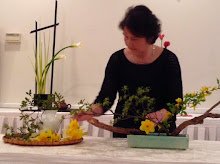
This is Textbook 2-20. I want to show you what Mizuhiki means in this New Years arrangement.

In the Ikebana world, the leading materials for New Years flower arrangement are pine, bamboo, Japanese plum, mum, camellia and lily. I have no problem finding pine and bamboo, they are right in my back yard. I also used leftover mums, carnations and some bittersweet. It is important to add Mizuhiki into your arrangement (gold or silver paper strings, symbolizing happiness or prosperity, etc...), so I put the silver ribbon on the right side in the bottom instead (you can click it to see the enlarged picture). 12/15/09

I like arts that created by simple elements. Above the pictures you posted online it just simply touched my heart likes a small water drop, drop in water, it flows smoothly and nicely. I look forward to seeing next art pieces of yours.
ReplyDelete